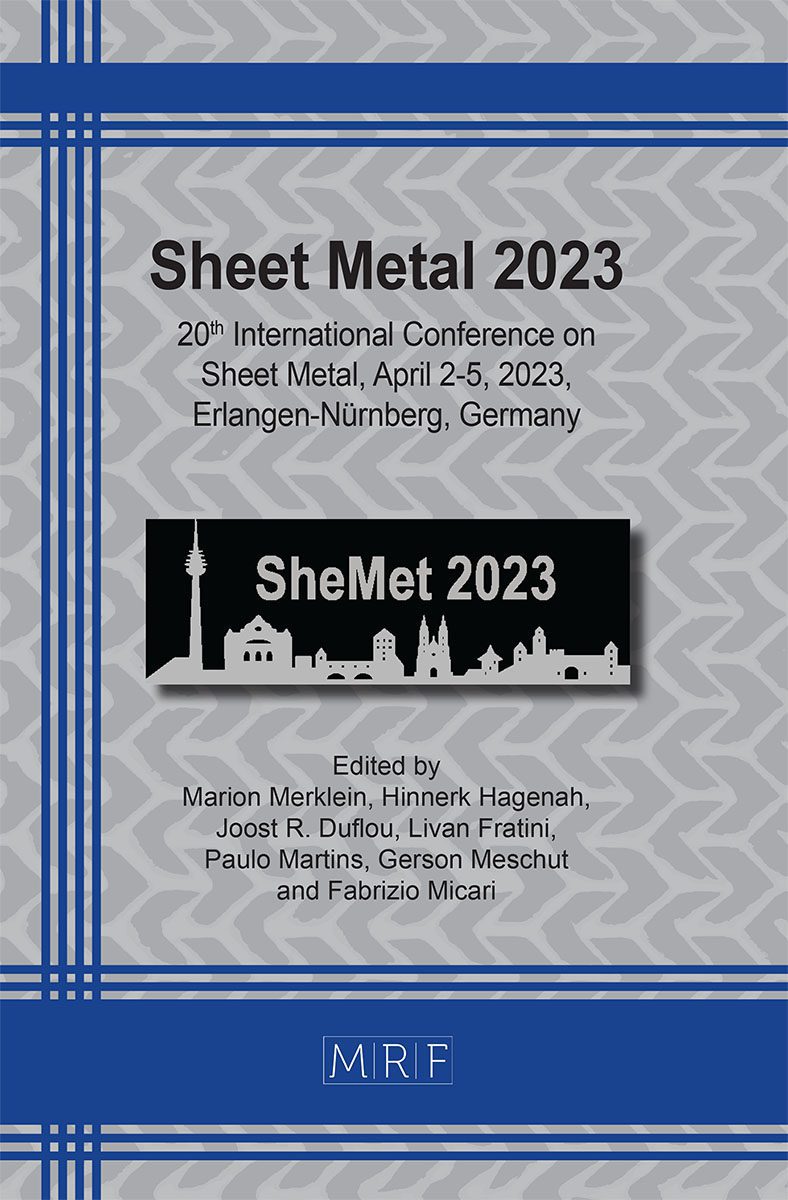Proof of concept for incremental sheet metal forming by means of electromagnetic and electrohydraulic high-speed forming
Maik Holzmüller, Maik Linnemann, Werner Homberg, Verena Psyk, Verena Kräusel, Janika Kroos
download PDFAbstract. The combination of incremental sheet metal forming and high-speed forming offers new possibilities for flexible forming processes in the production of large sheet metal components of increased complexity with relatively low forming energies. In this paper, the general feasibility and process differences between the pulse-driven high-speed forming technologies of electrohydraulic and electromagnetic forming were investigated. An example component made of EN AW 6016 aluminum sheet metal was thus formed incrementally by both processes and the forming result evaluated by an optical 3D measurement system. For this purpose, a forming strategy for electromagnetic incremental forming (EMIF) was developed, tested and adapted to the electrohydraulic incremental forming process (EHIF). The discharge energy, the tool displacement and the pressure field of the forming zone were determined as relevant parameters for the definition of an adequate tool path strategy. It was found that the EHIF process is less affected by larger distances between the tool and the blank, while this is a critical variable for force application to the component during EMIF. On the other hand, the more uniform pressure distribution of the EMIF process is advantageous for forming large steady component areas.
Keywords
Incremental Sheet Forming, Aluminium, High-Speed Forming
Published online 3/17/2023, 8 pages
Copyright © 2023 by the author(s)
Published under license by Materials Research Forum LLC., Millersville PA, USA
Citation: Maik Holzmüller, Maik Linnemann, Werner Homberg, Verena Psyk, Verena Kräusel, Janika Kroos, Proof of concept for incremental sheet metal forming by means of electromagnetic and electrohydraulic high-speed forming, Materials Research Proceedings, Vol. 25, pp 11-18, 2023
DOI: https://doi.org/10.21741/9781644902417-2
The article was published as article 2 of the book Sheet Metal 2023
![]() Content from this work may be used under the terms of the Creative Commons Attribution 3.0 licence. Any further distribution of this work must maintain attribution to the author(s) and the title of the work, journal citation and DOI.
Content from this work may be used under the terms of the Creative Commons Attribution 3.0 licence. Any further distribution of this work must maintain attribution to the author(s) and the title of the work, journal citation and DOI.
References
[1] Y. Koren, The Global Manufacturing Revolution, John Wiley & Sons, Inc., Hoboken, 2010.
[2] M. Callegari, D. Amodio, E. Ceretti, C. Giardini, Sheet Incremental Forming: Advantages of Robotised Cells vs. CNC Machines, ARS/plV (2006), pp. 702. https://doi.org/10.5772/4913
[3] W. C. Emmens, G. Sebastiani, A. H. van den Boogaard, The Technology of Incremental Sheet Forming — A brief review of the history, J. Mater. Process. Technol. 210, Germany, 2010, pp. 981–997. https://doi.org/10.1016/j.jmatprotec.2010.02.014
[4] W. Homberg, C. Beerwald, A. Pröbsting, Investigation of the Electrohydraulic Forming Process with Respect to the Design of Sharp Edged Contours. In Proceedings of the 4th ICHSF, Columbus, OH, USA, 2010, pp. 9–10.
[5] V. Psyk, C. Scheffler, A. Stalmann, M. Goede: Shaping of Sharp-Edged Design Elements by Electromagnetic Forming. In: Forming the Future. Miner. Met. Mater. Ser. Springer, Cham.
[6] M. Linnemann, V. Psyk, E. Djakow, R. Springer, W. Homberg, D. Landgrebe, High-Speed Incremental Forming—New Technologies for Flexible Production of Sheet Metal Parts. Procedia Manuf. 27, 2019, pp. 21–26. https://doi.org/10.1016/j.promfg.2018.12.038
[7] Harwey G W and Brower D F 1961 Metal Forming Device and Method US2976907 (Harwey G W and Brower D F)
[8] Z. Lai, Q. Cao, X. Han, N. Liu, X. Li, Y. Huang, M. Chen, H. Cai, G. Wang, L. Liu, W. Guo, Q. Chen, L. Li, A comprehensive electromagnetic forming approach for large sheet metal forming Procedia Eng. 207, 2017, pp. 54–9. https://doi.org/10.1016/j.proeng.2017.10.737
[9] V. Psyk, D. Risch, High-Velocity Forming, Sheet Metal Forming, ASM International, 2012, pp. 227-248. https://doi.org/10.31399/asm.tb.smfpa.t53500227
[10] Bühler H and Bauer D 1968 Ein Beitrag zur Magnetumformung rohrförmiger Werkstücke Werkstatt und Betrieb 9 513–6 (1968), S. 513–516.
[11] Psyk V, Risch D, Kinsey B L, Tekkaya A E and Kleiner M 2011 Electromagnetic Forming ‐- A Review, J. Mater. Process. Technol. 211 787–829. https://doi.org/10.1016/j.jmatprotec.2010.12.012
[12] S. Golovashchenko, Electrohydraulic Forming of Near-Net Shape Automotive Panels, Technical Report, U.S. Department of Energy Office of Scientific and Technical Information, Oak Ridge, TN, USA, 2013. https://doi.org/10.2172/1094831
[13] X. H. Cui, J. H. Mo, J. J. Li, J. Zhao, Y. Zhu, L. Huang, Z. W. Li, K. Zhong, Electromagnetic Incremental Forming (EMIF): A Novel Alumimum Alloy Sheet and Tube, Forming Technology J. Mater. Process. Technol. 214, 2014, pp. 409–27. https://doi.org/10.1016/j.jmatprotec.2013.05.024
[14] E. Djakow, R. Springer, W. Homberg, M. Piper, J. Tran, A. Zibart, E. Kenig, Incremental electrohydraulic forming ‐ A new approach for the manufacture of structured multifunctional sheet metal blanks, AIP Conference Proceedings, 2017. https://doi.org/10.1063/1.5008083
[15] T. Heggemann, V. Psyk, A. Oesterwinter, M. Linnemann, V. Kräusel, W. Homberg, Comparative Analysis of Electrohydraulic and Electromagnetic Sheet Metal Forming against the Background of the Application as an Incremental Processing Technology, Metals 2022, 12, 660. https://doi.org/10.3390/met12040660
[16] Faber L 2018 KOM lightweight aluminum chair, Information on http://elem-id.de/#Kom
[17] M. Linnemann, Analyse und Automatisierung von inkrementellen elektromagnetischen Umformprozessen, Berichte aus dem IWU, Volume 128.































